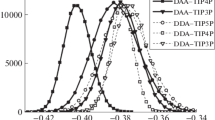Abstract—
The work presents algorithms and results of the direct computational experiment on mathematical modeling of water clusters treated as quantum systems numerically described using the corresponding Schrödinger equation. The method earlier developed by the author for Monte Carlo numerical solution of the Schrödinger equation is used. This method has proved itself to be quite time-efficient. Its input data are average positions of particles in a quantum system, for description of which a second method is developed. Several energy isomers of water clusters are found by the method for construction of average positions of quantum-system particles. The energy isomers of the water dimer, trimer, and hexamer given in the work are regarded as possible geometrical structures of water clusters and illustrate the use of the proposed methods for calculation of quantum systems.












Similar content being viewed by others
REFERENCES
K. E. Plokhotnikov, “About one method of numerical solution of Schrödinger’s equation,” Math. Models Comput. Simul. 12 (2), 221–231 (2020). https://doi.org/10.1134/S2070048220020106
K. E. Plokhotnikov, “Solving the Schrödinger equation on the basis of finite-difference and Monte-Carlo approaches,” J. Appl. Math. Phys. 9 (2), 328–369 (2021). https://doi.org/10.4236/jamp.2021.92024
Yu. I. Ozhigov, Constructive Physics (Nova Sci., New York, 2012).
N. F. Stepanov, Quantum Mechanics and Quantum Chemistry (Mir, Moscow, 2001) [in Russian].
J. Kim, A. T. Baczewski, T. D. Beaudet, et al., “QMCPACK: An open source ab initio quantum Monte Carlo package for the electronic structure of atoms, molecules and solids,” J. Phys.: Condens. Matter 30 (19), 195901 (2018). https://doi.org/10.1088/1361-648X/aab9c3
D. R. Hartree, The Calculation of Atomic Structures (Wiley, New York, 1957).
W. Kohn, “Nobel lecture: Electronic structure of matter—wave functions and density functional,” Rev. Mod. Phys. 71 (5), 1253–1266 (1999). https://doi.org/10.1103/RevModPhys.71.1253
V. V. Vedenyapin, T. S. Kazakova, V. Ya. Kiselevskaia-Babinina, and B. N. Chetverushkin, “Schrödinger equation as a self-consistent field,” Dokl. Math. 97, 240–242 (2018). https://doi.org/10.1134/S1064562418030122
K. E. Plokhotnikov, “Numerical method for reconstructing the average positions of quantum particles in a molecular system,” Math. Models Comput. Simul. 13 (3), 372–381 (2021). https://doi.org/10.1134/S2070048221030133
M. Yu. Tretyakov, M. A. Koshelev, E. A. Serov, V. V. Parshin, T. A. Odintsova, and G. M. Bubnov, “Water dimer and the atmospheric continuum,” Phys.-Usp. 57 (11), 1083–1098 (2014). https://doi.org/10.3367/UFNe.0184.201411c.1199
A. Mukhopadhyay, S. S. Xantheas, and R. J. Saykally, “The water dimer II: Theoretical investigations,” Chem. Phys. Lett. 700, 163–175 (2018). https://doi.org/10.1016/j.cplett.2018.03.057
S. S. Xantheas, C. J. Burnham, and R. J. Harrison, “Development of transferable interaction models for water. II. Accurate energetics of the first few water clusters from first principles,” J. Chem. Phys. 116 (4), 1493–1499 (2002). https://doi.org/10.1063/1.1423941
J. Cui, H. Liu, and K. D. Jordan, “Theoretical characterization of the (H2O)21 cluster: Application of an n‑body decomposition procedure,” J. Phys. Chem. B 110 (38), 18872–18878 (2006). https://doi.org/10.1021/jp056416m
I. Ignatov and O. Mosin, “Structural mathematical models describing water clusters,” Math. Theory Model. 3 (11), 72–87 (2013).
Y. Gao, H. Fang, and K. Ni, “A hierarchical clustering method of hydrogen bond networks in liquid water undergoing shear flow,” Sci. Rep. 11, 9542 (2021). https://doi.org/10.1038/s41598-021-88810-7
M. W. Feyereisen, D. Feller, and D. A. Dixon, “Hydrogen bond energy of the water dimer,” J. Phys. Chem. 100 (8), 2993–2997 (1996). https://doi.org/10.1021/jp952860l
A. Michaelides and K. Morgenstern, “Ice nanoclusters at hydrophobic metal surfaces,” Nat. Mater. 6, 597–601 (2007). https://doi.org/10.1038/nmat1940
Author information
Authors and Affiliations
Corresponding author
Ethics declarations
The author declares that he has no conflicts of interest.
Additional information
Translated by M. Potapov
About this article
Cite this article
Plokhotnikov, K.E. Modeling of Water Clusters by Numerical Solution of the Schrödinger Equation. Phys. Wave Phen. 30, 156–168 (2022). https://doi.org/10.3103/S1541308X22030074
Received:
Revised:
Accepted:
Published:
Issue Date:
DOI: https://doi.org/10.3103/S1541308X22030074




